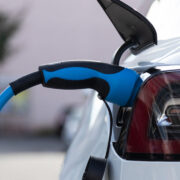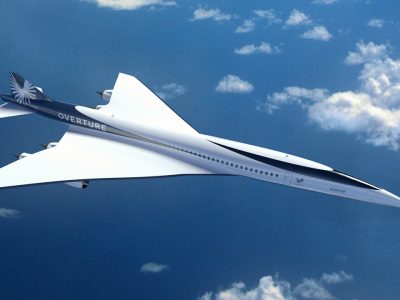With Tesla helping to popularize electric vehicles, I’m sure you’ve noticed more and more electric cars flooding our streets … but when it comes to electrifying transportation, one thing that we haven’t seen much of yet is electric aviation. There’s a lot of talk out there about whether or not electric planes have a viable future compared to electric cars and trucks. They’re often represented as the future of air travel and in an industry that carried over 4.4 billion passengers in a year1, real feasible electric planes could make a huge difference in combating the rising carbon emissions related to the aviation industry…
But why haven’t we seen electric planes take off yet? Are there any designs waiting in the wings? And is electric aviation really the savior it claims to be?
We often hear about the impact that the transportation industry has on the climate, in particular aviation. While commercial and industrial aviation only accounts for about 2% of global carbon emissions, the number of people flying each year is increasing… and fast. Some estimations predict that aviation will account for 25% of the global carbon budget by 20502. In the United States, domestic air travel is responsible for 9% of total US carbon emissions and flights departing from US airports are responsible for about 25% of passenger-related air travel emissions worldwide3. I don’t know about you, but that’s an alarming number to me. And one solution that’s gaining popularity is the potential use of electric-powered aircrafts to reduce that impact…
But let’s backtrack for a minute and take a look into the history of electric flight. Believe it or not, the idea and application of electric flight goes back as far as the 1880s when a few guys in the French army experimented by adding massive batteries and an 8-horsepower electric motor onto a balloon-type aircraft for the first time. But things went quiet on the electric front for almost 100 years.
It wasn’t until the 1970s that the United States Department of Defense started showing a bit of interest in trying to come up with some functional designs for electric flight. In fact, the program ended up being responsible for the first fully electric pilot-less flight across the English Chanel (~170km). Since the ’70s there’s been on and off interest in electric planes, culminating in a few recent notable examples. Projects like the Solar Impulse2, which started around 2009 and was the world’s first electric plane to circumnavigate the planet (2015-2016). And even more recently, the MagniX electric Cessna flight has brought the limelight back to electric aviation.
While we haven’t quite gotten to the point where electric planes are a common sight, there are actually quite a few companies working on different designs for small electric planes. Some are a little more outlandish than others, but there are a few pretty cool ideas out there. Some smaller airlines are even getting involved in the development process, like Wright Electric’s partnership with EasyJet on their proposed 186-seat electric regional jetliner4 or SAS’ investment in Airbus5. There are also designs being developed without the support of airlines, like MagniX’s E-Cessna and Eviation’s ALICE.
Current State of Electric Flight
And that brings me to my next point: Why haven’t we seen electric planes being rolled out on a commercial-scale? Well, it’s complicated. But basically it comes down to three things: the regulations, the cost, and the technology. And, not surprisingly, they all sort of go hand-in-hand…in hand.
When it comes to regulations, the FAA, and other regulatory agencies around the world, have very tight regulatory processes and for good reason. If something goes wrong with your car, you can pull over, but if something goes wrong with a plane … well … it’s a lot more complicated.
“If something goes wrong, you can’t stop. You can’t pull to the side of the road. There’s only one place for that airplane to go. And so the regulatory stringency is much higher, the requirements for reliability, redundancy, and safety are much higher for a good reason. You have no alternate.” –Chief Executive of MagniX, Roei Ganzarski
So, the regulatory stringency is adding time and complexity to developing electric planes, but there’s also the general gamble of trying to develop new technologies that may not pay off.
When it comes to cost, electric planes are a relatively unexplored frontier, meaning that oftentimes projects require significant upfront funding in order to be able to make any kind of meaningful progress. And, like any scientific research, it doesn’t always lead to the desired outcome.6 Take the Zunum Aero electric jetliner project for example.
After getting $1.3-million in funding from the private sector, companies like Boeing and JetBlue, and a grant from the State of Washington, the company reached a standstill in their research and ended up having to basically put the project on indefinite hold.
So developing an electric plane is a risky business in these early days, but once the technology is figured out, the cost of building an electric plane is generally on par with building a fuel-based plane7. In theory, electric flight would be drastically cheaper to operate, another reason why some are pushing it as a solution to a growing demand for airlines’ services.
Despite the challenges, there has been some progress with the technology. The electric plane that has shown potential for commercial use and successfully flown a test flight is MagniX’s E-Cessna in 20198. But it’s small and only flew a short distance. While it’s an exciting step in the right direction it highlights a stark truth: electric flight is still in the developmental stages.
Currently there is only one electric plane that is slated to be rolled-out in the next few years and that’s Eviation’s ALICE — which has a proposed range of about 1,000km, or about 621 miles. And that’s considered pretty significant. But what this shows is that electric flight is nowhere near being able to handle commercial trans-ocean flight paths.
Given all of these hurdles, what exactly can electric flight do for us?
Well, let me put it this way, you’re probably not going to take that European vacation on a fully electric flight over the ocean. But, if you’re headed a few states away to visit Grandma, electric flight actually looks like it might have a bright future. In fact, for a plane like the MagniX Cessna Caravan, it would cost $400 in conventional fuel for a 100-mile flight … but that same flight in their electric powered Cessna Caravan would run about $6 worth of electricity.9
As the Chief Executive of MagniX, Roei Ganzarski said:
“We’re not an environmentalist company, the reason we’re doing this is because it makes business sense.” -Chief Executive of MagniX, Roei Ganzarski10
Like I said before, regional air travel is responsible for a significant load of carbon emissions (and other gasses). And electric planes, at least in theory, seem like they might be able to handle the rigors of regional travel.
If you’ve watched some of my other videos you’ve heard a lot about the different applications of lithium-ion batteries and what they can provide for moving towards a more electric-reliant society. But one of the main issues with Lithium Ion batteries is that, well, they’re pretty heavy for their output.
In order for an electric motor to be able to power something like, say, the world’s largest aircraft — the AirbusA380 — it would need to carry batteries weighing 30-times as much as the equivalent fuel-load. That just, doesn’t add up. In fact, the plane would never get off the ground11…
The main reason that fully-electric planes seem like they’ll be limited to smaller ranges is because of the energy density, or specific energy, of different fuel-types. For example, the energy density of currently available Lithium Ion batteries is about 250Wh/kg while conventional kerosene-based fuel is closer to 12,000Wh/kg.
That’s a big difference.
And in order for fully-electric versions of common planes like the Boeing 737 or Airbus 320, to compete on longer routes of up to 700-miles, they’d need to carry batteries that had specific energies of at least 800Wh/kg.12
That might not sound like a big difference, but getting batteries’ specific energy from 250Wh/kg to 800Wh/kg requires a whole lot of innovation — and in an industry like this, innovation usually requires a lot of moolah.
Even to power a smaller aircraft, like something that had a 30-50 person occupancy, we’d need batteries that were able to reach energy densities of 500Wh/kg. And we’re just not there yet. There’s a general agreement among innovators in the electric plane realm that commercial electric flight is still a ways off. It’s kind of one of those eternal “10-years-away” technologies, but the difference here is that there’s a whole lot of ways to incorporate partially-electric planes into the game right now… unlike, say, Thorium-based nuclear power which either works or it doesn’t.
But, regardless of these hurdles there are some reasons to be optimistic that we’re on the cusp of seeing electric flight take-off … yeah, I said it …
In fact, there are some very cool designs and projects that are supporting smaller vehicles, like NASA’s X-57 Maxwell13, which focuses on very short travel and a cutting-edge design that incorporates 14 different motors into the plane’s wings and Uber’s plans to roll-out electric-powered VTOL taxis.
Actually, it’s worth a quick and dirty explanation of what VTOL is, because we’re likely to see it permeating our transportation pretty soon. VTOL stands for Vertical Take-Off and Landing and is descriptive of any aircraft which can take-off, hover and land all in a vertical formation. A common example would be the helicopter, but the tech is being extended to smaller and more efficient designs — likely to compete with the traditional road-vehicle. Most VTOL technologies are being designed for metropolitan or local use. However the F-35 Fighter Jet is a hybrid, being tagged as a STOVL — Short Take-off and Vertical Landing.14
Companies like Uber are toying with the idea of implementing VTOL aircrafts into cities. And there’s cause for excitement and concern. While it’s pretty cool, and maybe a bit scary, to imagine flying cars weaving through our cities, there’s also a lot of logistical issues with it, including, if the VTOL aircrafts are fully electric, where will we charge them?
Uber had planned on a soft 2020 roll-out of some VTOL tech in Dubai and Dallas Fort-Worth but that looks obviously delayed since this year has been wild already.15 Either way, VTOL certainly has a future in electric flight — but it will change the way we think about what flight really is.
The Future and Reality
So, I’ve talked a lot about the process of getting to where we are now with electric flight, but what’s next?
According to the Air Transport Action Group (ATAG), around 80% of the total carbon emissions from aviation come from flights longer than 1500km.16 And unfortunately that rules out any near-future electric powered planes. But ATAG also shows that some experimental fuels, based on algae, jatropha or waste by-product can emit up to 80% less CO2.
So many aviation experts are touting that the next-gen aircrafts will be electric-hybrids … and that could be a good stepping stone for companies to test some new electric designs while having to satisfy less regulatory steps.
In fact, there’s already a lot of work being done on large-scale (~100 seats) hybrid-electric planes. Airbus has plans to roll-out a hybrid electric aircraft by the 2030’s… and that’s basically the soonest and most realistic plan yet.
It’s no secret that the future of transportation has to be more efficient and limiting carbon emissions should be a priority. With the impact that the aviation sector has on the carbon budget, we’re likely to see more and more companies buying into at least some version of electric-based flight, even if it is only hybrid … and being done primarily to save money. With climate change being a front and center topic I’m excited to see what the future holds and if we’re really able to get Lithium Ion batteries to the level needed for electric flight to soar.
- Business Traveller: Air Travel 2018 ↩︎
- NY Times: Underestimation of air-traffic emissions ↩︎
- Center for Biological Diversity: Airplane emissions ↩︎
- Wright Electric and EasyJet ↩︎
- SAS and Airbus ↩︎
- Zunum runs out of funding ↩︎
- Short summary of electric planes: Fast Company ↩︎
- GeekWire: MagniX Cessna ↩︎
- GeekWire: MagniX and AeroTEC put all-electric Cessna airplane into the air for first time ↩︎
- BBC: Age of electric flight ↩︎
- BBC: Largest Electric Plane ↩︎
- VOX: Electric battiers for airplanes ↩︎
- NASA X-57 Maxwell ↩︎
- Wired UK: F-35B ↩︎
- Wired UK: Uber and VTOL ↩︎
- ATAG 2019 ↩︎


















Comments